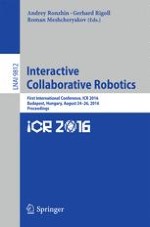2016 | Book
Interactive Collaborative Robotics
First International Conference, ICR 2016, Budapest, Hungary, August 24-26, 2016, Proceedings
Editors: Andrey Ronzhin, Gerhard Rigoll, Roman Meshcheryakov
Publisher: Springer International Publishing
Book Series : Lecture Notes in Computer Science
